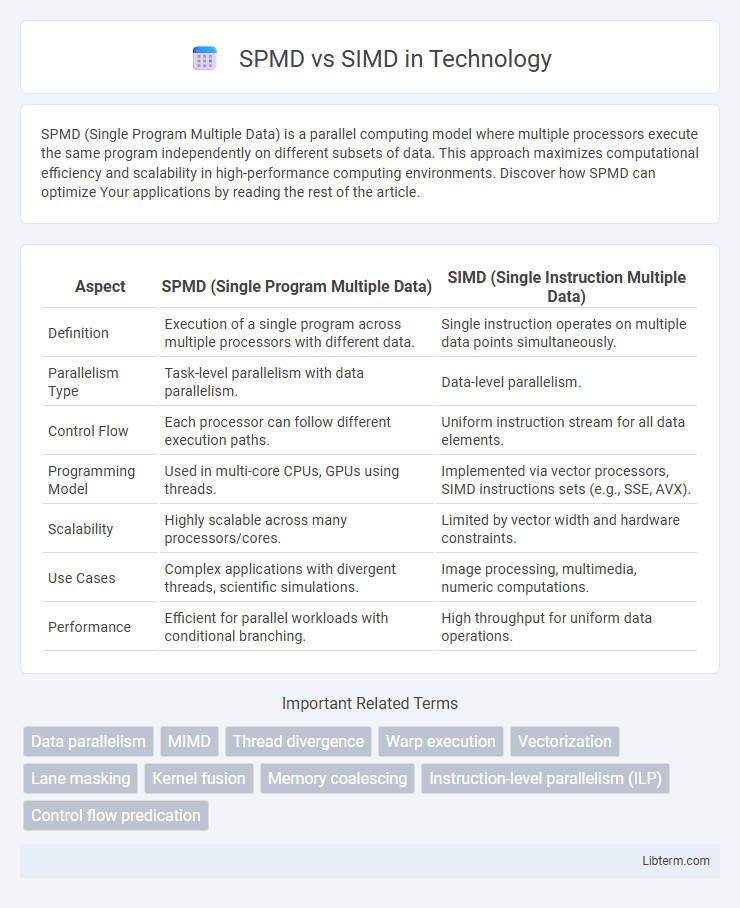SPMD (Single Program Multiple Data) is a parallel computing model where multiple processors execute the same program independently on different subsets of data. This approach maximizes computational efficiency and scalability in high-performance computing environments. Discover how SPMD can optimize Your applications by reading the rest of the article.
Table of Comparison
| Aspect | SPMD (Single Program Multiple Data) | SIMD (Single Instruction Multiple Data) |
|---|---|---|
| Definition | Execution of a single program across multiple processors with different data. | Single instruction operates on multiple data points simultaneously. |
| Parallelism Type | Task-level parallelism with data parallelism. | Data-level parallelism. |
| Control Flow | Each processor can follow different execution paths. | Uniform instruction stream for all data elements. |
| Programming Model | Used in multi-core CPUs, GPUs using threads. | Implemented via vector processors, SIMD instructions sets (e.g., SSE, AVX). |
| Scalability | Highly scalable across many processors/cores. | Limited by vector width and hardware constraints. |
| Use Cases | Complex applications with divergent threads, scientific simulations. | Image processing, multimedia, numeric computations. |
| Performance | Efficient for parallel workloads with conditional branching. | High throughput for uniform data operations. |
Introduction to SPMD and SIMD
SPMD (Single Program Multiple Data) is a parallel computing model where multiple processors execute the same program independently on different data sets, allowing scalable performance across distributed systems. SIMD (Single Instruction Multiple Data) processes multiple data points simultaneously using a single instruction stream, making it ideal for vectorized operations in GPUs and DSPs. Both paradigms enhance computational efficiency by exploiting data-level parallelism, but SPMD provides more flexibility for diverse program flows compared to SIMD's uniform instruction application.
Understanding Parallel Programming Models
SPMD (Single Program Multiple Data) enables parallel execution by running the same program across multiple processors, each operating on different data subsets, optimizing workload distribution in parallel computing. SIMD (Single Instruction Multiple Data) processes multiple data points with a single instruction simultaneously, enhancing data-level parallelism especially in vectorized operations. Understanding these models is critical for leveraging hardware capabilities in high-performance computing and efficiently solving large-scale computational problems.
What is SIMD (Single Instruction, Multiple Data)?
SIMD (Single Instruction, Multiple Data) is a parallel computing architecture that executes a single instruction simultaneously across multiple data points, enhancing processing efficiency for tasks like vectorized operations and multimedia applications. It is commonly used in modern CPUs and GPUs to accelerate computations by performing the same operation on multiple data elements in parallel. This approach significantly improves performance in workloads such as image processing, scientific simulations, and machine learning inference.
What is SPMD (Single Program, Multiple Data)?
SPMD (Single Program, Multiple Data) is a parallel programming model where multiple processors execute the same program independently on different pieces of distributed data, enabling efficient data-parallel computation. Each processor runs the same code but operates on distinct data sets, allowing scalable performance in high-performance computing and GPU programming. SPMD contrasts with SIMD by allowing more flexibility in control flow and branching within each processor, improving parallelism in complex applications.
SPMD vs SIMD: Key Differences
SPMD (Single Program, Multiple Data) executes a single program across multiple processors, each handling different data independently, allowing for scalable parallelism suitable for complex algorithms. SIMD (Single Instruction, Multiple Data) applies one instruction simultaneously to multiple data points, offering high throughput but limited flexibility in divergent code paths. The key difference lies in SPMD's versatility to manage diverse task execution across cores versus SIMD's optimized approach for uniform data-parallel operations.
Advantages of SIMD in Modern Computing
SIMD architecture enhances parallel processing by executing a single instruction on multiple data points simultaneously, significantly boosting performance in tasks like multimedia processing, scientific simulations, and machine learning. It enables efficient utilization of CPU vector registers, reducing instruction overhead and power consumption compared to SPMD approaches. The ability of SIMD to leverage data-level parallelism makes it indispensable for accelerating algorithms in modern GPUs and CPUs.
Benefits of SPMD in Parallel Processing
SPMD (Single Program Multiple Data) enhances parallel processing by allowing multiple processors to execute the same program independently on different data sets, improving scalability and load balancing compared to SIMD (Single Instruction Multiple Data). This model supports more flexible and complex computation patterns, enabling dynamic decision-making within each processing unit. SPMD's ability to handle divergent control flows and irregular data structures results in higher efficiency and better utilization in heterogeneous computing environments.
Real-world Applications: SPMD and SIMD Compared
SPMD (Single Program Multiple Data) enables efficient parallel processing in large-scale scientific simulations and complex machine learning models by assigning identical program code across multiple processors handling different data sets. SIMD (Single Instruction Multiple Data) excels in image processing, graphics rendering, and vectorized computations by performing the same instruction on multiple data points simultaneously within a single processor. Real-world applications often combine SPMD and SIMD to maximize performance, leveraging SPMD for distributed data tasks and SIMD for fine-grained data-level parallelism.
Challenges and Limitations of SPMD and SIMD
SPMD faces challenges in efficiently handling divergent control flow, leading to performance degradation when threads follow different execution paths. SIMD's limitations include its reliance on data-level parallelism, making it less effective for problems with irregular or conditional data access patterns. Both models encounter scalability constraints as increasing complexity and synchronization overhead can hamper performance gains in large-scale parallel applications.
Choosing Between SPMD and SIMD: Best Practices
Selecting between SPMD (Single Program Multiple Data) and SIMD (Single Instruction Multiple Data) depends on the nature of the workload and hardware capabilities. SPMD excels in scenarios requiring independent thread execution with different control flows, common in GPU programming and parallel CPU cores. SIMD is optimal for data-parallel tasks with uniform operations on multiple data points, such as vectorized math computations and multimedia processing, leveraging CPU instructions like AVX and NEON.
SPMD Infographic

 libterm.com
libterm.com